#evanuris
Text

ghilan'nain, mother of the halla 🦌
#been obsessed with her (and her potential horrors) lately so. behold 👍#dragon age#ghilan'nain#evanuris#elvhen#my art#kinda want to draw a horror-y companion piece to this now#ARRRGHAAAGHAA posting art is so nerve wracking
474 notes
·
View notes
Text
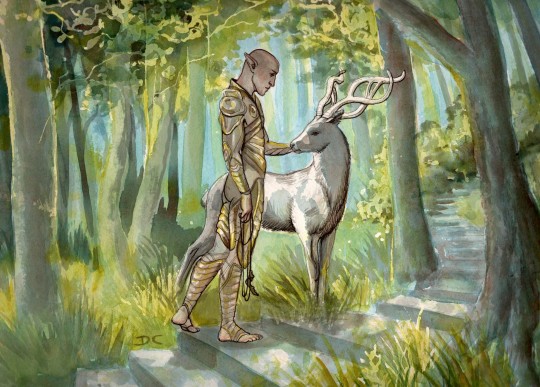
Solas, Arlathan
Long ago, there was a time when Solas admired every new creature of Ghilan'nain, and the Halla were his favorite.
She was the only Evanuris capable of creation instead of destruction.
Acrylic ink and fineliner on bamboo paper.
#solas#solasmance#solas dragon age#solas x ghilan'nain#dragon age inquisition#my fanart#my art#art#dai#dragon age#ghilan'nain#evanuris#the dread wolf rises#ancient solas#solas dread wolf#halla#dragon age fanart#dragon age dreadwolf#yes i know Solas had dramatic hair during his arlathan time#but i imagine this scene after he started to lead the slave rebellion#and so he would already have humbled his apearance#what can i say i like the egg bald#seeing people modd Solas with luscious locks makes me cringe a bit#i like that he's weird looking?#im just saying#give me the egg so bald and shiny i can see my own reflection please#solas fanart#traditional media#traditional illustration#Dazechroma
305 notes
·
View notes
Text
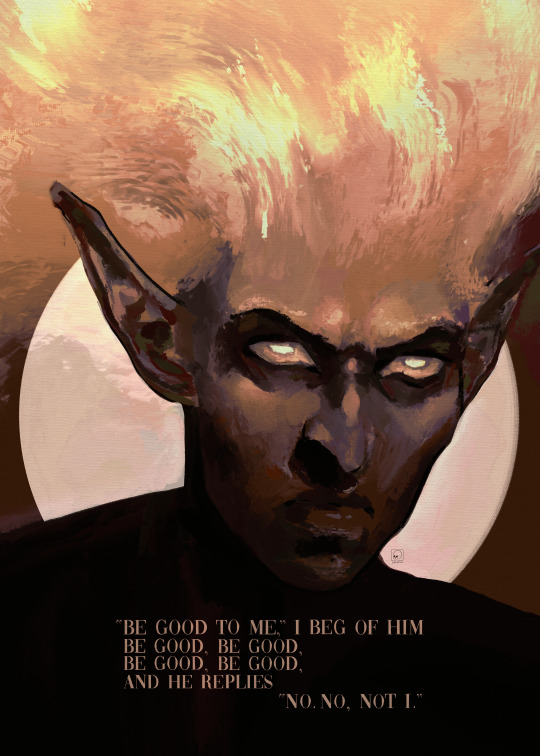
Jastober 26. your favourite song (but make it a dragon age fanart, in this case Elgar'nan) . prompts
"I'm the paper cut that kills you. I'm the priest that you ignored. I'm the touch you crave, I'm the plans that you made, but fuck all your plans I'm bored. Can't you hear that scratching?" - Unwanted Animal by The Amazing Devil
#elgar'nan#elgarnan#evanuris#dragon age inquisiton#dragon age#mine#my doodles#dragon age fanart#dragon age inquisition#jastober#jastober 2023
207 notes
·
View notes
Text
Evanuris ??

The characters with beautiful helmets on the vinyl cover of the Dragon Age soundtrack obcess me !! Who are they ?
I also drew Flemeth, Fen’Harel and a character that appears in a trailer (next to the character with a pickaxe helmet)
Nine elven gods.
I have soooo many questions !!!!!
(My assumptions about their identities (from left to right) :
Andruil, Mythal, Dirthamen
Sylaise, Fen’harel, June
Ghilan’nain, Falon’Din, Elgar’nan)
#dragon age#evanuris#dragon age fanart#dragon age theories#mythal#andruil#fen’harel#dirthamen#Sylaise#June#ghilan’nain#Falon’Din#Elgar’nan
279 notes
·
View notes
Photo
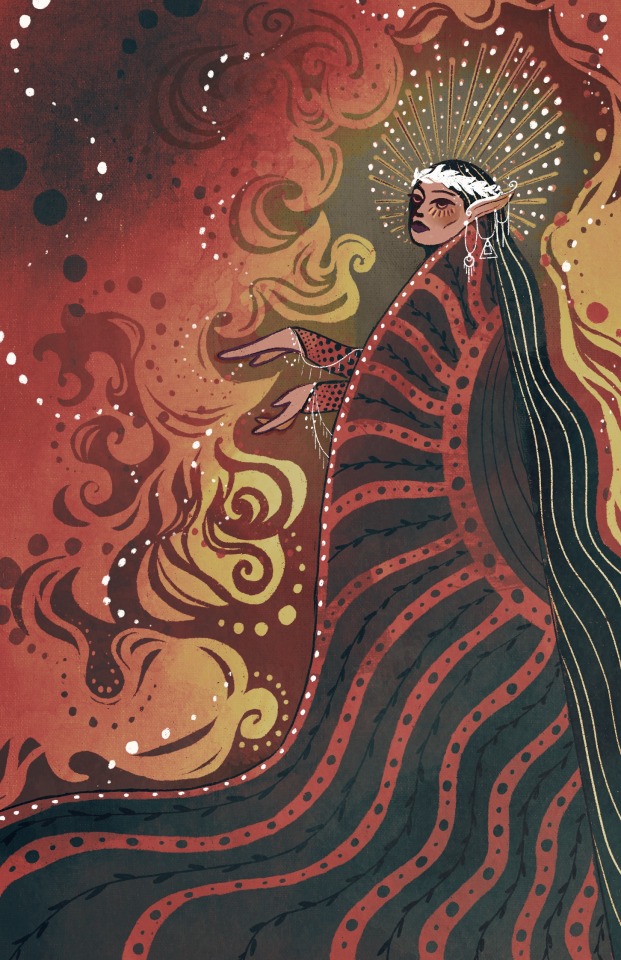

Sylaise and June
#damn I love drawing fire#don't know why it took me so long to get around to drawing these guys#also yes I will be drawing the egg man but I'm working my way up to the heavy hitters so he's last#evanuris#sylaise#june#dragon age#dragon age inquisition#dragon age elves
442 notes
·
View notes
Text

Day 17. Evanuris
#dragon age#dainquisition#dragon age fanart#lavellan#ancient elven inquisitor#inquisitor lavellan#dai#dragonage#da ocs#Thia Da'halla Lavellan#evanuris#elvhenan#inktober#inktober2023
126 notes
·
View notes
Text
There’s something shady going on with the Chantry, guys...
...apart from the endless abuses of the rights of mages/elves/states’ sovereignty, I mean. I am currently working on the textures of the Inquisition Chantry robes for a mod, and I couldn’t help notice this decoration on the cleric robes looks and how suspiciously like “Moonhead” from the DA:D teaser images it looks:

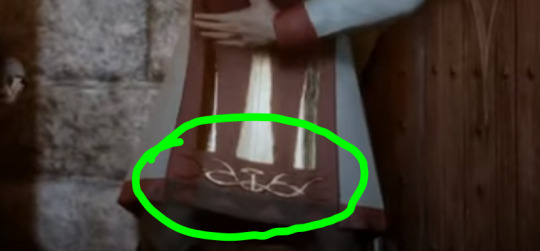
There’s not just the obvious crest, but even stylised tentacles. And after the latest mural it is a given that Moonhead is an Old God... one of those gods that Andraste was allegedly waging her war against?! So why is THAT on the uniform of the faith she started?

And then, when I was looking for a picture of the statue on the right, Google showed me this, and now I’m just screaming:

What the actual fuuck?! This isn’t really a theory tbh, just me going slightly insane at possible implications of this...
WHAT THE ACTUAL HECK?
...
And that’s not even getting into how the sun burst is the Chantry’s own symbol but there’s again an Old God who also has it as theirs?

Or whatever this is supposed to mean, idk:

What does it all mean?????
I wanna hear people’s theories - please! Make it make sense!
#Dragon Age theories#my theories#dragon age#dragon age inquisition#dai#evanuris#old gods#mythal#andraste#meredith stannard#chantry#elvhenan#moonhead#dragon age dreadwolf#da:d#da: dreadwolf#dragon age symbolism#dragon age meta#trespasser#dragon age trespasser#trespasser murals#bride of the maker#da4#da4 speculation#dragon age speculation#chantry critical#FUCK THE CHANTRY
246 notes
·
View notes
Text
So i haven't seen anyone on this site do a full on dive on what little material we do have of dreadwolf. For a title that's gonna come out next year if its not delayed, there's shockingly little that's actually out, and what there is can be divided into two.
In game images, and artwork.
For this post i wanna focus on the art.

The most famous of the art is of course this piece. Solas in both his Elf guise and True form, both reaching for the red lyrium idol Hawke and Varric found in DA2.
First things first, before we got confirmation through Urthemiel's concept art, this was the first rock solid proof that the Evanuris were the Old Gods. 7 were sealed away, 2 yet remain, just like the orbs we see here so clearly connected to the taint through the red lyrium idol.
Now a couple of things about this idol.
1. It keeps regenerating. Inquisition did not in any way tell us about this, but this idol keeps regenerating regardless of what happens to the original.
Meredith's lyrium body was hollowed out from the inside out, and the lyrium had used her internal parts to remake itself, where it was taken by certain expanded DA universe characters.
Thats how its back despite being made into a sword, then infecting meredith.
2. The way this picture frames it, this seems to be the key to Solas goal of ripping down the veil, entering the Fade in the flesh and remaking the world.
That's not really the interesting part. No the interesting part is that this isn't the first, or second or third, but fourth completely separate object Solas seems to theoretically be able to use to undo his great work.

In the most recent trailer, we see him use a seemingly completely different artifact to try to do the job, but given the fact this is likely going to be the opening introduction of the game, whatever he's trying to do with this artifact is most certainly going tk go wrong somehow, and might tie into the main character of the game's strange ability to summon magical weaponry out if nowhere.
Maybe a sorta repeat of what happened in the inquisition? His great ritual is interrupted and derailed by some random schmuck that absorbs it's power and becomes his arch enemy?
That would explain how this random thief leader guy that this game is supposed to be headed by, becomes able to defeat Solas.
Assuming this is correct, this means that after this ritual fails, his eyes will instead turn to the red lyrium idol.
Also as i said, that would bring Solas artifacts that could be used to accomplish his plans to backtrack on the veil to a total of 4.
The first was The Mask of Fen'harel, from Redemption, an artifact that was clearly meant as a possible failsafe, given it had the capacity to rip down the veil even in the hands of a mediocre mage, nevermind Solas as he is now.
The mask was destroyed in that series, before Solas even woke up, forcing him to try to rely on his second option, his orb, his Foci, which was also destroyed in Inquisition.
Thirdly there is this strange, green, wand thingy, that seems likely to fail in some way.
And fourthly there is the red lyrium idol, which was the source of all red lyrium that has since plagued the world.
And speaking of the blight...
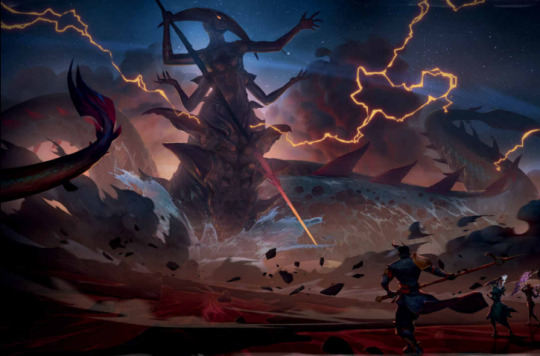
There are two remaining old gods, and we know how Urthemiel would have looked like in his uncorrupted state through his statues.
This is another of the old gods, uncorrupted by the taint, though which of the Evanuris this is i have no idea. A true eldrich abomination.
Regardless, while Solas is the main villain, we'll be fighting at least one more Elvhen God in this game, which assuming the other one is not fought and/or killed, means there will be one more at the game's end.
One more potential blight.
Or not as we'll see below.

From what very little we have seen of the main character, they seem to have the ability to summon a magical energy weapon. If i had to guess, this seems to be a concept art piece for that.
It also seems to be set at the final area of tresspasser(wherever that is), and the fade seems to be really powerful here at this moment, given those gloating rocks.
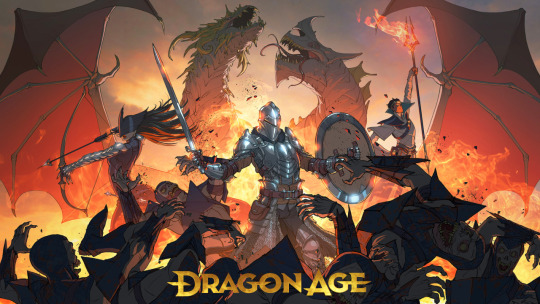
Not too enlightening, except for the fact there are Two archdemons in the background who may, or may not be blighted.
Guess all the evanuris as waking up in this game after all.

Shockingly enough given the last two old gods will awaken in this game, we'll get one, final dig into the deep roads before they become irrelevant as a setting.

There's some concept art for what is clearly companions, but i wanted to highlight this one along with the big one im ending this speculation post on.
The three figures from the wall aren't too interesting looking(I think the foremost guy is the pc), but the guy on the far left seems to be a avaar, given his Hakkon helmet.

Apparently we're gonna get water diving in this game, either as a cutscene, or in game play.
The guy with the mustache seems to be Dorian, though it could be a new companion rather than a returning one. The lady on the left looks like isabela, but given the glowing, magical knife, i think this is concept art for the female version of the pc, before they settled on the whole summoning the weapon.
Also the fact we're finally getting sea levels, hopefully means we get to see and possibly fight the last of the important lore monsters, the Cetus.
Seriously, if this series ends without us even getting to see the gigantic, electrical sea dragons of the Northern ocean depths, i will be so mad.
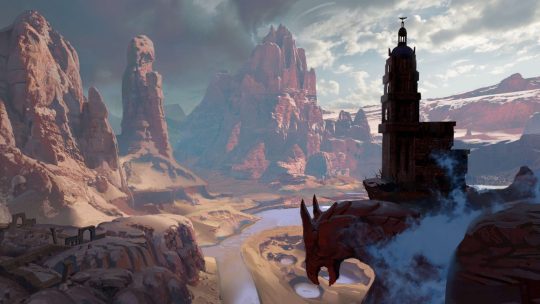
The anderfels, likely Weishaupht, the only place we know for a fact that we'll visit in game, given our only glimpse of gameplay so far takes place there.
Again, this game will likely be the final time the grey wardens are relevant, so of course we're visiting the great Warden fortress, and taking a look at what the hell's going on there.

Alright, so one of the first pieces of art we ever got, and it seems to be the companions of what is likely going to be the last dragon age game.
Left to right, i think the lady on the far left is the lady with the mask from the big battle scene artwork. If so, probably an antivan crow with a mask and a rapier.
Next is a Qunari, though what class is hard to say.
Next one is definitly a rogue, though seemingly male.
Looks like the Inquisition's horse master to be honest.
Next is who I'm assuming to be dorian.
And after him, there is the most interesting part of the piece, a figure with either a thick hood, or thick white hair, holding what is very, very clearly a gun.
Which is not too surprising. Gunpowder has been on the verge of being cracked since awakening, and the Inquisitor discovered the recipe in tresspasser, so guns being invented in the meantime makes perfect sense.
No clue about the next two, but the final one is very, very clearly related to the Navarran death mages, though wheter it's a mortalatasi, or a spirit bound to a body by them is hard to say.
Regardless they all seem to be a ragtag bunch compared to Inquisitions group. Which would fit with the idea that they are supposed to be a bunch of thieves and such that'ss forced into a battle for the world.
#dragon age#dragon age dreadwolf#meta#speculation#dorian pavus#tevinter#anderfels#grey wardens#evanuris#old gods#arch demons#concept art
68 notes
·
View notes
Text
DREADWOLF

#dragonage#dragon age inquisition#dragon age solas#solas#dragon age dreadwolf#da: dreadwolf#art#fanart#digital art#fenharel#evanuris#solass#my art
947 notes
·
View notes
Text
tried my hand at painting landscape for my egg

mar solas ena mar din
“your pride will be your downfall”
#my art#this took so long and my carpal tunnel hated me for it#dragon age art#dragon age#dragon age inquisition#dragon age fanart#da inquisition#da fanart#solas dai#solas fan art#solas dragon age#da solas#solas dread wolf#dai fanart#dai art#evanuris#fen’harel#dragon age dreadwolf#dread wolf#solas x inquisitor#solas x lavellan#lavellan x solas#solavellan#solavellen hell#digital art#artists on tumblr
299 notes
·
View notes
Text
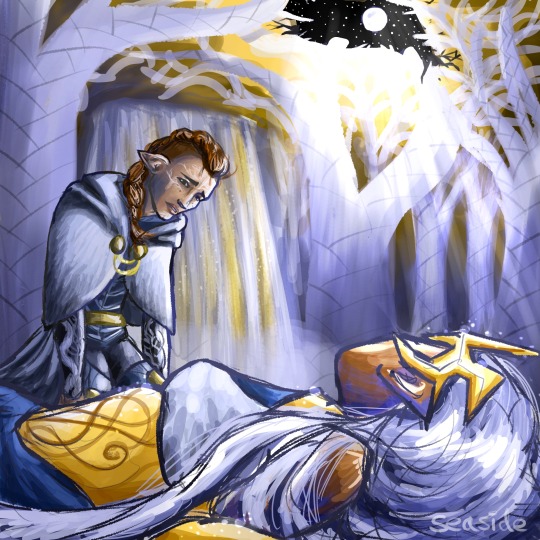
his greatest failure
#dragon age#dragon age solas#dragon age fanart#dragon age mythal#solas#mythal#evanuris#maker preserve#digital art
24 notes
·
View notes
Text
Dragon Age Iconic Patterns: The Sun

In this post I will try to extensively gather all the sun-based or sun-like imagery that we find in all the games of Dragon Age. From the most typical ones to those which may seem obscure or with a hidden allegory/design. I will qualify their resemblance with the Sun symbol as Strong, Weak or other.
This post contains the following symbols
Chantry Sunburst
Elvhenan Culture: Sun symbol among the Evanuris
Elvhenan Culture: Asterisk Symbol and Elvhenan Doors
Elvhenan Culture: Golden Ring
Elvhenan Culture: Crappy Sun
Elvhenan Culture: Elgar’nan and Sylaise
Elvhenan Culture: Murals
Tevinter Culture: Green Star
Tevinter Culture: different decorative elements
Dwarven Culture: Fairel and Dwarven art
Ferelden Culture: The Sun Face and the geometrical Sun
Grey Wardens and the Sun
Avvar and the Sun
Flemeth
Qunari, Par Vollen, and the Solium Constellation
DAO design
Free Marches Rural Areas
[This post belongs to the series “Analysis and speculation of Statues”]
[Strong] Chantry Sunburst
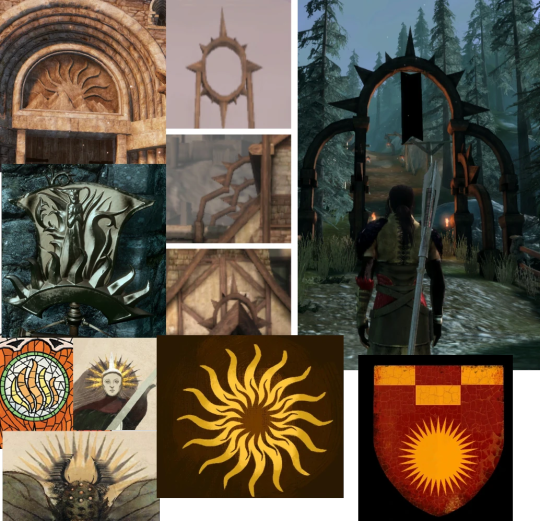
The most typical one that appears in DA series is the Sun or Sunburst with wavy rays, repeated so much along the games that we can identify it immediately. It’s the unequivocally symbol of the Chantry. We found it in many versions, and it represents the “dawn” with the idea of hope and “new beginnings”, but also the fire that “purified” Andraste in her pyre to let her ascend to the Maker’s side. In the posts of Andrastian Art [Andrastian Design: Stained Glasses], we also find that “balls of fire” [which can be interpreted as a Sun in another way] are shown to represent the Maker or the Faith in Him.
Andraste’s single spiked helm seems to be inspired in a single sun ray, at least this is what an illustration in the Chant of Light [book of World Of Thedas] seems to suggest.
In general, most of the representations of the Chantry Sun have 16 rays.
The same sun-like symbol appears in its Tevinter version when we see the Imperial Chantry; the only difference with the Orlesian one is that the Tevinter Sunburst has straight rays.
As a detail, in DAO, we had the typical representation of the wavy sunburst present in some strange devices of Tevinter origin, for example, the ones we found in [Brecilian ruins], while the main Church in Denerim, or in Haven, display spikes that, more than resembling a sun, look like thorns or even a thorny vine. This may be a consequence of an original plan in linking, design-wise, the chantry symbology with the thorny vines that represent the Blight or the Darkspawn [As we explained in the section “Non-mural symbol: Thorny vines” from Murals in DAI: Basics], or merely it was a limitation of the design of the game, as we know DAO suffers from.
We also know that tranquils should display this symbol on their foreheads, burnt with lyrium, but as we saw along DAO, none of them had it. Later we were informed that the devs had problems to add this mark on the npc, therefore, it was never shown until DA2. When it comes to this symbol, it is interesting to see that tranquils carry the metaphor of “a Sun burning their minds and emptying them”, which may or may not be related with Dwarves and their fear to the Sun and potential relatinship of Elgar'nar shoving a fire ball into their underground lands [More details of this concept in Deep Roads [DLC Trespasser]: Lower Walkways in particular with the codex Torn Notebook in the Deep Roads,].
[Strong] Elvhenan Culture: Sun symbol among the Evanuris

Strangely close to the Chantry Sunburst symbol, we find the “half” sun symbol [tagged along the blog as Sun-head creature] in what we suspect was one of the ancient primordial dragon symbols that some Evanuris took over when they claimed Divinity [for more context, read Attempt to rebuild Ancient Elvhenan History]. It’s hard to say which Evanuris took control of this symbol, but we know there is a clearly sun-like symbol present in the Crossroads of the DLC [as a statue, check The Crossroads [DLC Trespasser]: Entrance] and in the Shattered Library [as an Eluvian, check Shattered Library; Entrance and Courtyard]. With the release of the Vinyl, we also discovered and reinforced the hypothesis that this symbol belongs to or was co-opted by an Evanuris [read Speculations about the Vinyl Art for details] thanks to the image of an elf wearing a hat with that shape.
A consistent detail of this image is that it’s a half-sun with exactly 7 rays.
[Weak] Elvhenan Culture: Asterisk Symbol and Elvhenan Doors

If we extend this imagery, and check other symbols that may look similar to a sun, we find the ancient Elvhenan Doors [Elven Ancient Shard-based door], which top displays a pointy sun of 8 rays that may or may not be related to the Asterisk symbols [also related to the Titan’s core, which I talked about in the post of Murals “The Death of a Titan”]. In the way the door gets illuminated when activated also makes us see a “circle” in it that can be loosely related to the “Golden Ring shape”. More details about this ring will be treated below.
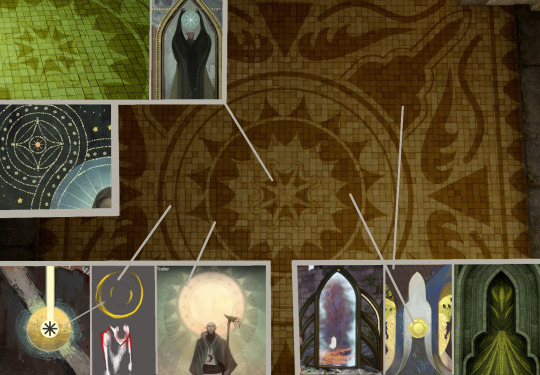
This strange sun on the ancient door also makes us think in the Asterisk Symbol [made of 8 points], which lays at the centre of the yellow mosaic, which may be related to the core of a Titan [asterisk of 8 points too]. The link is immediate when we see that this asterisk is outlined by a shape that looks like a star or a Sun, inside a big ball with triangular-shape ends. This same symbol appears in the last Trailer of DA4, behind Solas, when he is presented like an Hermit, mysterious, apostate mage. Around this “sun” we can make out several concentric lines that may refer to a “Golden Ring”.
The Asterik symbol also appears in murals such as “The Creation of the Veil” or “The Death of a Titan”, which allowed us to relate them with the core of a Titan and its immense power of "making real what you imagine"reinforcing the reality", but this symbol also appears in a corner of Solas’ tarot card.
The yellow mosaic also has some shapes at the four corners that may represent eluvians or something related to Mythal. In the mural of “the Temple of Mythal” from “The actions of the Inquisitor”, we see that Solas draw a particular star of 8 points inside a door frame that resembles this “eluvian outline”, but it’s also the shape of the doors of the Temple of Mythal which represents Mythal herself in her dragon shape. All these symbols seem to reinforce the idea we explored in “The Death of a Titan”: Mythal seems to be related to the core power of a Titan represented by an asterisk that evolves into a golden ring and into a sun.
As I repeated several times in Speculations about the Vinyl Art, at times, we find some hints where stars or balls of fires [also understood as suns] are related to Mythal and Elgar’nan, making us suspect that, maybe, Mythal and Elgar’nan share a nature similar to Falon’Din and Dirthamen’s: apparently, the same creature with two different aspects from them. If this were the case, associating Mythal with the Sun would make sense, and it would also explain why, if Elgar’nan was so central in the Elvhenan culture, there are so few representations and statues of him, while Mythal overwhelms it.
[Weak] Elvhenan Culture: Golden Ring

During the last trailer of DA4, we see Solas turns into the Black Dread Wolf as a sun in the background becomes a moon [single golden circle] and later, it separates itself into concentric rings, that may or may not be related to the “Golden Ring” so deeply entangled with Elvhenan culture. Thanks to this imagery, we may relate the Sun to the Golden Ring [specially if we consider that the mural presented in Nation Art: Elvhen displays the yellow ring in a position that may be considered “the sun”, but also the "authority/power above"]
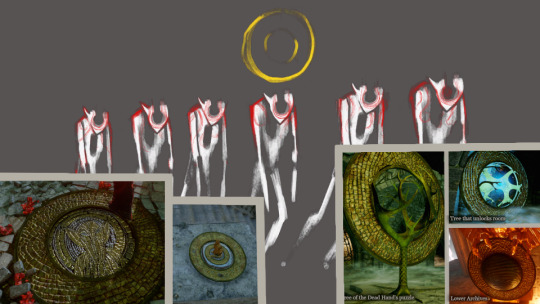

We need to remember that the Golden Ring’s presence is always associated with control, power, and occasionally to Mythal and Dirthamen. In the mural of the “zombie elves”, it’s above all of them, and due to this position, it could be interpreted like a “sun” or moon upon the controlled, zombified elves. But I’m not too convinced in this interpretation, since we already explored in posts such as: Nation Art: Elvhen, Exalted Plains: Ghilan’nain’s Grove and the Dead Hand, DLC: Jaws of Hakkon - Frostback Basin, Elvhen Tomb, Ancient Elven codices; Fen’Harel’s mountain ruins, The Crossroads [DLC Trespasser]: Elven Mountain Ruins; Vine-covered Tower, Murals in DAI: The Death of a Titan, and Speculations about the Vinyl Art that this ring was more related to control, power, or even forced change/shape in some cases. Due to its power or potential knowledge, it's also associated to Dirthamen Owl [which also could be Andruil's owl according some inconsistencies in the same Unreliable Dalish legends].
On the other hand, it’s never clear if this symbol may have morphed into a sun along the ages with the loss of memory that the Elves had throughout generations when they lost their immortality. However, I tend to consider that this Golden Ring may have changed into a Sun when it entered in contact with human groups, in the same way that I see the story of Fen'Harel gave enough context for humans to create the Maker myth based on him, potentially during the time of Halamshiral [for more details, read The Chantry and the Mythology of the Chant of Light]
This ring also appears in the last scene of DAI, when we defeat Corypheus, showing Mythal inside it, as bits of red lyrium sprout around it. This can be related to many speculations done in Speculations about the Vinyl Art, where we can conclude that another fragment/part of Mythal is still trapped in the Black City, corrupted, and contained by an immense power that may have been used before by the rest of the evanuris to control their own people.
The Golden Ring has also been seen enclosing Elven Tree Statues and Elven Orbs, implying its relationship with elvhenan power and/or Mythal’s [after all, we know that Mythal took the power from a Titan from which elvhen orbs were developed, and trees are also her symbol, according her vallaslin]. It's worth noting that the only working orb we saw in the game was Mythal’s, so far.
[Weak] Elvhenan Culture: Crappy Sun
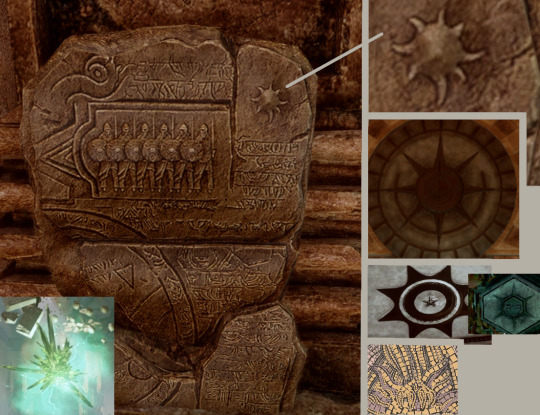
There is also a strange symbol that I called “crappy sun” in the ancient tablet we find at the entrance and deep into the tomb of Forbidden Oasis: Solasan Temple [along this blog I’ve tagged it as “Stone in Razikale-Ceremony-style”]. It’s hard to say if it represents a sun or a breach. It may be related to a sun similar to the one of the Elven Ancient Shard-based door that, later, Tevinter co-opted to turn into the several versions of pointy suns we see in Tevinter Pre-blight ruins, [let’s remember they were not Andrastian yet, and still they had this symbology in their buildings and elements because it may have been related to ancient dragons, or taken from another elvhen symbology during the time of the Dreamers since there are some proofs, such as the Tevinter Mosaic [Invasion], that may show that Tevinter had a better relationship with elves back then].
Maybe the original symbol was related to Elgar’nan, as we see in his mosaic, where he shoves down the sun into the earth, and its rays are wavy and a bit “crappy”. If this relationship is correct, maybe what Elgar'nan shoved into the Earth to destroy the dwarves/Titans was not a sun but a breach? Again, a very unlikely hypothesis.
This “crappy sun” also has 8 rays.
[Strong] Elvhenan Culture: Elgar’nan and Sylaise
Elgar’nan’s mosaic was interpreted in the post Evanuris, and basically shows an elf shoving down a Sun of wavy rays into the Earth. It’s easy for us to relate this image to the unreliable Dalish legend of Elgar’nan [read Elgar'nan: God of Vengeance]. Elgar’nan is presented here as the son of the Sun itself, who tried to burn all life on the Land out of Jealousy, so Elgar’nan vowed vengeance against his Father’s cruelty, and his rage won against the fire of the Sun. Then, “Elgar'nan threw the sun down from the sky and buried him in a deep abyss created by the land's sorrow.”
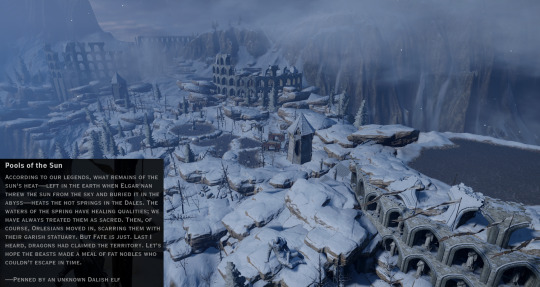
This story can be followed later in the post Emprise du Lion: Pools of the Sun, where we find another unreliable Dalish legend claiming that this place has spring waters because it was here where Elgar’nan shoved the sun into the Earth. I also made a link to Sylaise considering the Elvhenan arenas we can see in this region, the presence of Sylaise’s Shrine, and her thirst for being always competing with someone. These details can make us suspect that this Sun could have been Sylaise [so deeply related to fire, the sun, and also as angry as Elgar’nan according the Song to Sylaise].
It’s very worth noting that these two legends, said by different clans, claim that Elgar’nan pushed the Sun into the Abyss. Another detail we have to assume is that "Abyss", "Beyond the Deep Roads" and "The Void" seem to be one thing related to the places where the Titan sleep [or even inside the Titan themselves] instead of a strange dimensional pocket we never saw before. This links the Elvhenan with the Dwarven in what we speculated in Murals in DAI: The Death of a Titan.
With this relationship, we see again the Sun as a weapon of destruction and control.
[Weak] Elvhenan Culture: Murals

Murals present a red sphere with rays that may imply a Sun .
In the mural “The Creation of the Veil” [1], we find a red sphere inside a black one, making us suspect it’s the big evil released by the Evanuris that Solas isolated with the creation of the Veil. Around it, there are seven “bubbles” with similar “rays” in grey and golden colours that may imply “gates” that would allow us the access to the central “sun” or red sphere.
In the mural “The Death of a Titan” [2] we talked extensively about the asterisk symbol, its representation of a Titan’s heart and all that power associated with it, as well as with Golden Rings. The codex in here speaks of a red sphere that contains fury, and maybe all of this can be related to a sun, or better said, the other way around: a Sun as a sphere of fire, related to fury, and buried below underground to contain its destruction. This also brings us some similarities with the unreliable Dalish legends about Elgar'nan.
In the mural “Red Lyrium Idol” [3] we also commented how the image looks as if Solas were walking on a sphere of fire. It may be related to the red lyrium idol too. Here, we keep linking this idea of a “sphere of fire” as a potential Sun.
In the murals of “The actions of the Inquisitor” [4], we see several times that the red sphere associated with the big evil isolated behind the thick, impenetrable barrier of the Black City seems to be positioned in places that may allow a soft interpretation as a “sun”in the sky.
These symbols seem to gather more importance as we analysed the Vinyl Art, where we find the concept of the Eclipse [as an ominous symbol of Fen’Harel that covers and hides the Sun] and a lot of iconography of stars, which can be interpreted as “suns”.
[Weak] Tevinter Culture: Green Star

Pre-Blight Tevinter art has a “star” symbol that may be interpreted as a sun, specially if we consider that the inside of this green star displays the symbol of the elvhenan Golden Ring in red colour. However, it seems more likely to be a symbol representing the power that one can extract from the Breaches. The green colour helps in this interpretation and puts it a bit farther away from a sun interpretation than other symbols. However, it keeps linking the Golden Ring with the power of creating a Breach.
[Confusing] Tevinter Culture: different decorative elements
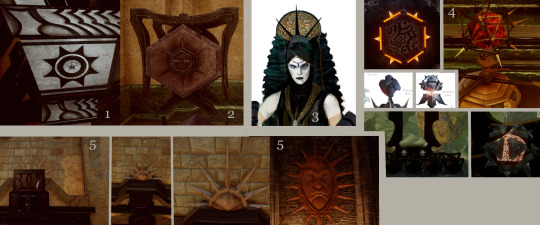
The rest of the symbols in Tevinter objects may have some relationship with the Sun. For example, we find doors, boxes, and columns decorated with an 8-pointed star [1] but we also find another one with 6 points in something that looks like a box [2]. The shape of an “hexagonal” sun of 8-pointy rays can be found as well in objects like the “scrying orb” [4].
Among the outfits, we find a 3-ray comb used by Tevinter women [3], which may be related to the sun-based symbol of an Old God [and potentially related to the corresponding Evanuris associated with it]. This symbol is a lot closer to the "Sun-head creature" we found among Elvhenan objects.
As a curious one, I will always point out the strange, hidden Sun figure that belongs to the Free Marches decoration that can be found at the entrance of the Inner Sanctum in Western Approach: The Still Ruins, Viridis Walk and Inner Sanctum.
I think it’s clear and safe to say that most of the sun-based symbols present in Tevinter culture [and previous to their conversion to Andrastian religion] may have been originated from the contact with the Elvhenan [during the Dreamer time where we can see less repulsion to Elvhen according the Tevinter Mosaics] or [most likely] with the dragons that may have been related to the Elvhenan, as I made the connection in the comic post The Missing.
[Weak] Dwarven Culture: Fairel and Dwarven art

The Dwarves, at least the ones in the Fairel’s ruins, may have some link with the Sun as well. In these ruins we find the same exact stone tablet we find in the Ancient Elvhenan tombs [1], which displays the “crappy sun” I commented above. Once again, it could be a sun but also a breach, so there is no much sense to keep focusing on it.
Another symbol to relate the Sun to the Dwarves may or may not be an old “Dwarven stone-paintings” we saw since DAO, which basically shows a dwarf working the stone [3]. Based on symmetry, we could assume that the triangles on the background are stalagmites, but if we stretch-out this interpretation, they could even be seen as a sun with its rays. It’s very unlikely, since it seems to be more a design resource to highlight the scene of the stone-painting, but for completion’s sake I think it’s worthy to keep it commented here.
However, this simple design allows us to interpret it in different ways: the spikes we see can be pieces of rock protruding from the ground and the Dwarf in it is mining them [as its original codex in DAO seems to imply], but also it could be understood as a quarter of a Sun peeking through the corner of the image as a Dwarf works tirelessly.
Later in DAI we are introduced to another piece of art of similar characteristics [2]. The building was never possible to be identified unequivocally, and in posts like “Architecture of Kirkwall : Gallows and Lowtown/Darktown” I related it to representations of Kirkwall or cities that may be similar to Kirkwall where the runecraft mastery of dwarves was used [and probably, it was a source of pride for these clans, who may have kept the achievement immortalised in a piece of art reproduced among the noble dwarven families]. This piece also shows a background very similar to the one in [3] that may be a representation of stalagmites or a sun, if it’s stretched-out enough.
Another strange symbol in the dwarven furniture is the one presented in some stone-seats: an elaborated metal image that shows thorny vines on or over a sun [4]. This symbol appears in many other parts of the game where there are dwarven rooms, but also in Arbor Wilds :Cradle of Sulevin where we can read the Vir Tanadhal, However, in this case, the symbol is not completely the same one than in the Hissing Wastes: Fairel tomb.
It’s hard to suspect if this is a mere reuse of assets, it has a lore-related meaning, or it’s just a reflection that the Dwarves and the Ancient Elvhen had a relationship quite ancient [as it shows the Elvhen tree and its dwarven, more geometrical style, that I’ve been pointing out since DAO in Orzammar]. We have to remember that the Ancient Elvhenan saw the dwarves as soulless creatures, workers of the “pillars of Earth” and worthless. However, I always claimed it was never clear if this was a reference to ancient Dwarves that were linked to the Titan deeply to the point that they became Sha-Brytol after the break of the link, or were related to more independent dwarves as the ones we see now, who have a sense of Stone, but can’t understand the Titan with the exception of some gifted ones [such as Valta].
Finally, the dwarves have an additional aspect related to the Sun in the very unreliable codex called Torn Notebook in the Deep Roads, Section 2. I wrote about this codex in a more integral way in Deep Roads [DLC Trespasser]: Lower Walkways. But basically an ex-Dalish elf [now a Qun converted] relates Elgar’nan’s fire [which another unreliable Dalish legend, Elgar'nan: God of Vengeance, claims he shoved the Sun into the Earth] to the fear to the Sun that Dwarves experience [Read the section Elgar’nan and Sylaise above]. This may have been a Dev’s choice to makes us aware that there exists a relationship between the Sun and the dwarves, even though there is no lore material that can make it clear enough.
[Strong] Ferelden Culture: The Sun Face and the geometrical Sun

In the Tryptich presented in Andrastian Design: Tapestry and Tryptich, we find three symbols on top of each part of the scene: the six-snakes that represent Tevinter, the golden city above all the image representing the Maker or the Chantry Religion, and over the section of Ferelden/Orlais chantry, a 8-pointed sun which rays look like triangles. Once again, the resemblance of this symbol with the elvhenan sun in the mural “Temple of Mythal” is remarkable [check the Temple of Mythal in “The actions of the Inquisitor”] or the sun shape in the elvhenan yellow mosaic or in the background of Solas in the Trailer of DA:D. This could come from different roots:
1- An Orlesian root, considering how much of the elvhenan influence it had during the time of the Halamshiral and the coexistence of humans and elves in the Dales for some years [to the point where inter-racial families were made, as it was hinted all over the Exalted Plains]. I spoeculated how the idea of the Maker may have been developed during this time in the post The Chantry and the Mythology of the Chant of Light
2- Another potential root is related to the Alamarri root, and therefore, linked to the Avvar: this sun may be a representation of the Lady of the Sky for the same reasons I will explain below in the Section Avvars and the Sun.
We can find similar icon in the book World of Thedas, where they show a unique Ferelden Tryptich [3], which top displays this symbol with a sun that even may have a shape of a Golden Ring within it. In either case, we know that this symbol later was part of the Ferelden Chantry, which sun is very pointy, as DAO showed it [see the first section in this post: Chantry Sunburst].
In DAI, we find in some small towns of Ferelden, a unique strange Sun with a crying face [1]. On it we see a bird and a squirrel. It’s hard to know exactly what this is, [check the post Nation Art: Ferelden], but maybe it can be understood as a representation of Andraste made by Ferelden culture mixed with some local animals and fables created as a mixture of cultures, similar to the tale that related Wyverns to Andraste [check the wyvern section in Dragon Age Iconic Patterns: The single spike].
There is also a fish drawn in the DLC of Hakkon on a fisherman shack [2], which displays a pattern that can be related to the “crappy sun” designs on its skin. Not sure what to make about it. The closest is that the Avvar represented this symbol as a way to reflect what they may have seen in the Isle of the Lady, where a big ancient breach have been there, open, since the time of Telana [read about this in “The Veil and the preservation of the Waking World” from the post Frostback Basin [DLC]: Miscellaneous ].
[Strong] Grey Wardens and the Sun

The typical symbol of the Grey Wardens involves a chalice that represents the Joining ritual. It always displays a Sun, and not any sun: it’s one with a strong resemblance to the Sunburst of the Chantry. Let’s remember that the Grey Wardens was and is an independent Order that doesn’t respond to the Chantry, and even more so: it was created before the existence of the Chantry, and before Andraste was born. So any quick explanation that this sun is present in this object due to some potential influence from the Chantry seem unlikely.
However, as I showed in Western Approach: The Still Ruins, Main Chamber and Hall of Silence, there are griffons with this same chalice that belonged to pre-Blight Tevinter, maybe remotely associated with Dumat in some ways [since they appear in a hall called “Hall of Silence”, and Dumat=Silence]. We know that the Joining, as a ritual of blood magic, came from the knowledge of Arlathan elves and Tevinter Mages during the desperate times of the First Blight when nothing seemed to stop the darkspawn and even slaying Dumat did not work the first time. Therefore, this Sun may have some relationship with the elvhenan, the Old Gods, or just the blood magic that allowed the creation of the Joining.
[Curious] Avvar and the Sun

The Avvar have a symbol that I always found very Sun-like due to its design and cultural concept: The Lady of the Sky. It’s not only the concept; the lady of the sky can be any important object in the sky; moons or suns. Since Thedas has two moons, it seems more plausible to think of her as unique as the Sun itself.
In the painting that represents her (found on a wall in the Frostback Mountains) we see a design of an owl which shape looks like a Sun. Even her sculpture in Skyhold displays small spikes around her neck which give her a low-key “sun-like” design, specially if we relate this shape with the “sun” shape we saw in the Ancient Elvhenan Yellow Mosaic or with the star we saw in the “Temple of Mythal” mural [in “The actions of the Inquisitor”] or with the Sun that appears behind Solas in the trailer.
Curiously, her banner displays her eyes in a shape that looks similar to the Golden Ring shape, but in black colour. That the Avvar have an art that may have resemblance with Elvhenan's is not strange for me if we remember that Tyrdda Bright-Axe Path’s story narrates that her lover was an elf that, as it is hinted, may have been the Lady of the Sky herself. This means that the Avvar always were a culture under the influence of the Elvhenan and the Dwarves [due to the marriages they arranged with the children of the Stone].
[Weak] Flemeth
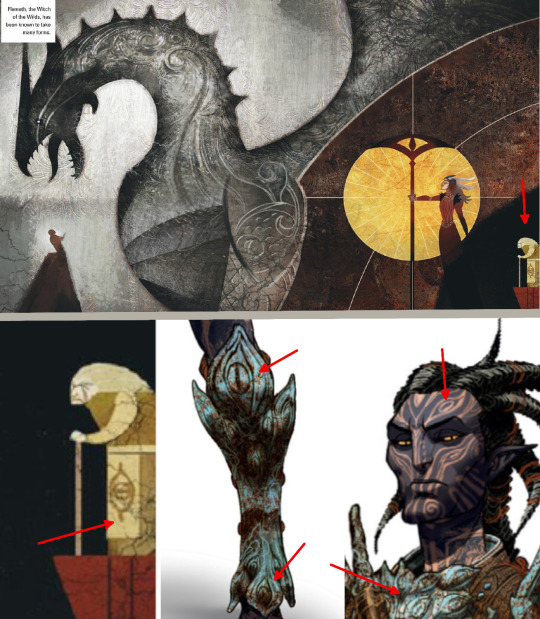
Flemeth also had a unique concept art that shows all of her nature in one drawing: her dragon shape, Mythal, as the central part of it over a human figure that may be a petitioner; a bit aside and as if she were in a inner ring of a brown sphere, The Witch of the Wild: Flemeth, with a very particular staff inside a yellow circle that may be interpreted as a Sun. And very hidden in the corner, in the core of this sphere, now black, we see her as an "old, old woman" with a big eye drawn on her apron, at the edge of a cliff [potentially representing the fragment of Mythal that lives inside her]. This kind of eye is very similar to the ones that we see in the concept art armours of Mythal’s temple guardians. I assume it has to do with her omnipresence due to the manipulation of dreams [we know that she presented herself in dreams to an elf and marked him with the Vallaslin of Mythal after awakening, check the video]
Mythal also has bland hints related to Elgar’nan symbology, which is related to the sun, fire, and balls of fire with anger [check all this in the posts Speculations about the Vinyl Art and “The Death of a Titan”]. Flemeth ends up being related to all this since she carries a fragment of Mythal in her.
[Strong] Qunari, Par Vollen, and the Solium Constellation

The Qunari have little link with the Sun, but not the land they conquered. In the book World of Thedas we are informed about the existence of the Fex, a race we never saw nor had much information beyond the fact that they exist. May they be related to the Sun or a Sun-base proto religion? We don't know.
In the Codex Constellation: Solium, we learn that this constellation [which looks like a Sun/Star, image above, pretty similar to the Chantry Sunburst I may add] may have been a representation of the Sun or the Moon [or both] for the Neomerian [Ancient Tevinters], however, it could also represent Elgar’nan, since unreliable Dalish legends claim him to be the “eldest of the Sun”.
Another Codex, called The Pyramids of Par Vollen, tells us that the Jungles of this continent have ancient ruins that doesn’t seem to be tombs but places of scientific purposes. The shape of these ruins fits perfectly with the constellation of Solium, making them, in some way or another, related to the Sun. These pyramids are a great mystery in the DA lore, especially for their total lack of information beyond this codex. We know their walls show images of “intricate sea creatures, shipwrights, musicians, archers, and kings. Odd figures are depicted, tall, horned, always in a position of authority and respect.” It seems that there was no resistance when the Qunari came to conquer this place, so we can suspect that this previous civilization embraced the Qun without much resistance, in part, because the Qunari have horns, and that caused respect and authority. Or the civilisation had been gone long ago when they came. Or it was a civilisation that was developed by or under the authority of the Kossith, the ancient Qunari who had no Qun.
The brief description of these ruins also makes me link it, potentially, with the underground ruins we find in The Horror of Hormak .
[Confusing] DAO design
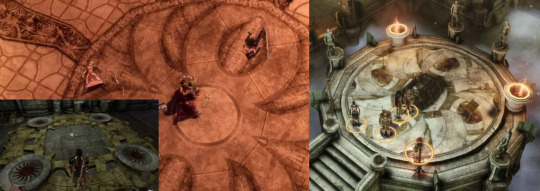
This section tries to relate the Sun shape with designs that may make the connection a bit stretched or not truly reasonable, therefore, DAO leads this part, lol.
We find that many places along the game, specially the ones related to puzzles [Honnleath and Enchanter Wilhelm’s basement] or to Tevinter experiments [Ruins of Brecilian Forest] display a platform on the ground with a symbol similar to the Sunburst of the Chantry. I’m not sure why they are there, specially in the Brecilian Forest, since we know this was a fortress probably developed by Tevinter [ which potentially may have co-opted, as usual, an ancient Elvhenan building and claimed it as its own] just to be taken by Dalish and humans later. This Fortress is a mess in terms of design and statues that it displays, so it’s hard, if not impossible, to truly take it seriously. To me it all feels more like a reuse of graphical resources, but just for the sake of completion, I add the present section.
More of these sun-like platforms can be found in the Tower of the Circle of Magi [which could potentially make sense since the tower was made by Avvar and Dwarves, and it may be a representation of the Lady of the Sky, as we saw in the Avvar section of this post] but also in the Temple of Andraste or in Denerim at the Fort Drakon which makes less sense [unless it is taken as a symbol from the Chantry itself]. Again, these inconsistencies make me suspect the reuse of assets in a game that could not afford to have 5 different platforms designs.
[Confusing] Free Marches Rural Areas
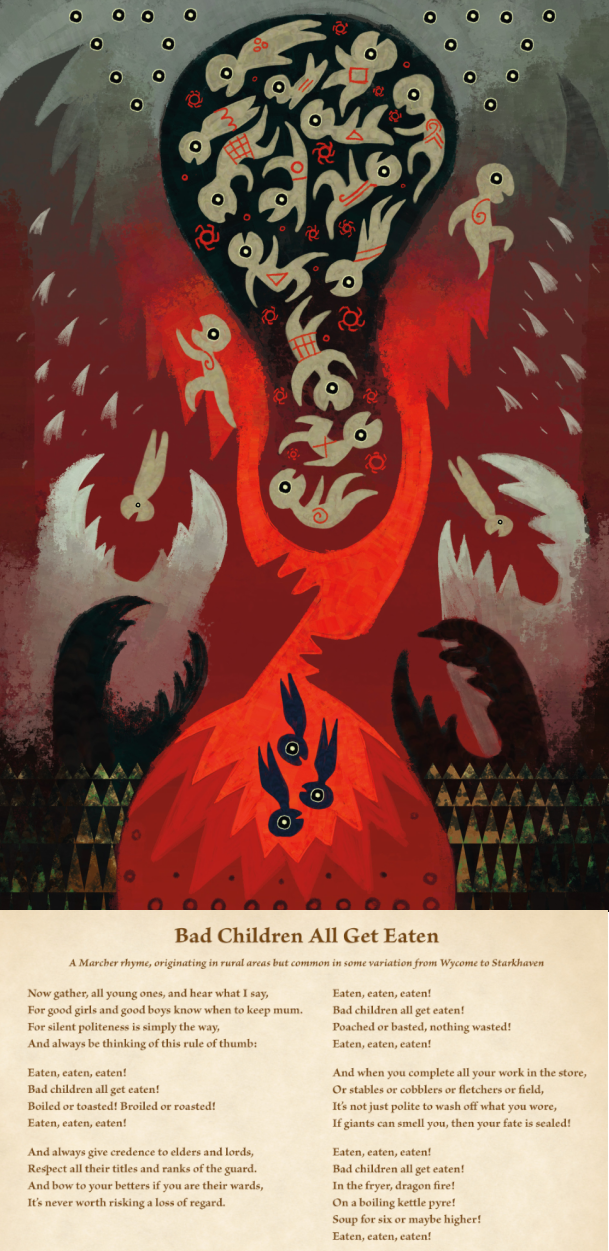
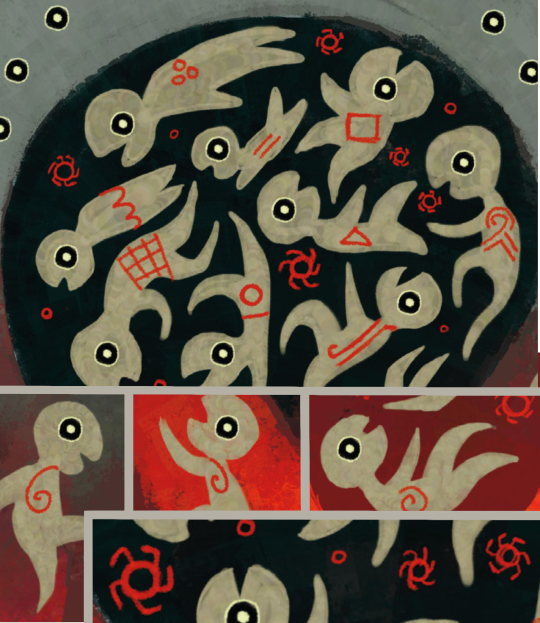
Another place where I found a sun-like symbol was in a very disturbing image of the book World of Thedas associated with a cautionary tale told to Free Marches kids. In it, we see that people/children are punished if they go outside a bubble of darkness with small “sun-like” symbols floating around. Each of these kids have a symbol on their belly or head. Curiously, one of these symbols is a small spiral that I’ve brought the attention upon long ago in the post Hinterlands: Statues, paintings, and structures found in the open where we found the alamarri statue I called Eroded dragon skull which has a “G symbol” on its back, which, at the same time, seems similar to the one present in a reiterative way all over the elvhen artefacts and in some dwarven rug designs.
I don't know how to interpret this image, mostly like the big black bubble that contains these klids seems to protect or shield them from the dangers outside. The kids that "behave badly" are dropped outside of it and are consumed by the dragon fire/jaws of the dangers outside. So in a very stretched way, we can interpret this image that the bubble filled with Suns protects people, or at least, it's the right path to follow not to be eaten by those monsters outside.
Conclusions
To put an end to this post, I would like to bring a short conclusion that we may have reached together along it. The Sun in Thedas is an ancient symbol that mostly every culture took to exploit and use in their own representation of gods/power.
This fact alone is not strange, since in anthropology we can see that severals cultures on Earth have developed religious rites or created Gods out of the Sun itself. The Sun is a symbol related to warmth, light, food, life, and security, so it seems reasonable for DA Lore to take it as the main symbol of Thedas civilisations.
The Sun in current Thedas is immediately associated with the Chantry and Andraste: it is a symbol of hope, of dawn, that provide the idea of new beginnings; it’s also the idea of the Maker itself and the Faith people have in him. It's also the fire that purifies in order to grant ascension [Andraste's case].
When it comes to Elvhenan, the Sun is immediately related to Elgar’nan, who was considered, according to the underaliable Dalish legends, the son of the Sun itself, who in order to save the Land shoved the sun into the ground, potentially causing a great damage to Dwarves and Titans.
There is also a symbol of a half-sun in an Eluvian, a statue, and in a hat worn by an elf, that may suggest that an original god, represented by the sun [potentially an ancient Dragon] was worshipped by the Evanuris. Lately, that symbol may have been co-opted by one of the Evanuris when they took divinity and the identity of the ancient gods they worshiped.
Elvhenan also seem to take the symbol of the asterisk as an oversimplification of the Sun, which across the murals, is also related to the heart of Titans, to power, and to the Golden Ring, which is also associated with control. So, for Elvhenan, we may suggest that the Sun represents immense power, if not, Divinity itself, that may end up being related to the core of Titans. The asterisk is also associated to the orb, a big power object.
Since Elvhenan were the first civilisation we know that started in Thedas [besides the Titans and their children], their symbols of power [asterisk, orb, golden ring] may have evolved along time to reach human groups which developed, later, all the sun symbols that ended up in the Chantry’s.
Thanks to Tevinter, we also can suspect that the Sun may have been a representation of an Old God, since they have a lot of sun-related images in their decoration and objects that belong to ancient times in which they were not Andrastian yet [in fact, so ancient times that Andraste herself was not born yet]. This may mean that the Sun symbol cloud have been taken from the Elvhenan or from the Ancient Dragons. Through Tevinter style, we also realise that the Elvhenan Golden Ring may have been used to create Breaches, which again shows and seems consistent with the idea of relating it to power and control. The symbol of Sun in Tevinter culture may be related originally with Elvhenan or with Ancient Dragons that Tevinter used to worship.
Dwarves have little representation of the sun for obvious reasons, but due to the unreliable legend of Elgar’nan and the war with the Titans, we may establish a relationship in which the dwarves endured the Sun [or the Elvhenan power] at some point in their story.
Thanks to the Grey Warden we can relate a sun with the idea of ancient Blood magic or ancient Dragon blood knowledge, since the Joining is represented by a chalice with a Sun on it.
The Avvar also have a low-key representation of the Sun in their Lady of the Sky, which may be just consequence of their deep relationship with the Elvhenan culture.
Par Vollen may have more answers about the Sun and ancient times, but the lore of DA world is very scarce on this region of the map of Thedas, so we can only speculate.
#Analysis and speculation of Statues#golden ring#alamarri#avvar#Chantry#Dragons#Elvhenan#Flemeth#Grey Warden#High Speculation#Old Gods#Tevinter#Par Vollen#sunburst#Sun-head creature#evanuris#Elven Ancient Shard-based door#yellow mosaic#mythal#flemeth#Elven Owl statue#Stone in Razikale-Ceremony-style#Sylaise#Elgar'nan#Asterisk Symbol#Free Marches Sun#Dwarven stone-paintings#lady of the sky
26 notes
·
View notes
Text


Still obsessed with the way I drew these two dorks. Definitely need to redraw this piece BC I got my inquisitors face all wonky and I feel like I could do something more with their poses but I feel it fits Calliope and Falon'Din really well
#dragon age#inquisitor lavellan#falon’din#dai#dragon age inquisition#lavellan#evanuris#elf#draws#artist on tumblr#art
23 notes
·
View notes
Text

I redrawn a painting that appears in the Dragon Age comic book « The Missing » I love them ! Are they Evanuris ? Andruil and Ghilan’nain ??
41 notes
·
View notes
Text
been toying more and more with evanuris characterizations. some loose ideas under the cut bc i expect this will get rambly
initial caveat that this is just how i see them and isn't necessarily purely sourced from canon etc etc
mythal (the great protector) - calculating, cunning, observant, patient. she plays the long game as a matter of course. she's also selfish and self-centered given the esteem she's been treated to for so long, and can be somewhat mercurial
elgar'nan (god of vengeance) - brash, demanding, uncompromising, determined. he doesn't stop and doesn't fail - if he does 'fail,' that's just a sign that he needs to keep going until it isn't a failure anymore. easily driven to extremes of emotion, with a volatile temper
falon'din (friend of the dead, the guide) - haughty, persuasive, charismatic. he and dirthamen have a special relationship and awareness of each other, but where dir keeps to himself, falon'din plays the role of elgar'nan's eldest (alongside his twin brother of course) and has the same powerful presence as his father does. he feels like he is the natural successor to elgar'nan's throne, in due time.
dirthamen (keeper of secrets) - reserved, enigmatic, condescending. where falon'din performs his duty as child of elgar'nan and mythal, dir all but abandons his own, throwing himself instead into his studies with an affected disregard for anything beyond them. despite these appearances, he is in fact deeply in touch with the goings-on in arlathan and with the other evanuris and has more than once played a long manipulation, some even unknown to his brother.
andruil (goddess of the hunt) - driven, patient in the hunt and impatient in life, manipulative, jealous. i think with her, exploring the... void? i can never remember, anyway it fucked her up, made her more paranoid and selfish, made it so that she felt like she had to control everything to be safe and remain in power. i think prior to that she was still selfish and entitled, but also more sincere in her desire to protect her family and improve her skills
sylaise (the hearthkeeper) - detached, contemplative, observant, meticulous, reserved. i think she's associated with the vallaslin and its application, and i tend to see her as being somewhat withdrawn from the other evanuris, with the possible exception of june (her husband and/or brother - orrrrr maybe both. i could see the evanuris being... like that. keeping the bloodlines 'pure' and all that)
june (god of the craft) - obsessive, single-minded, distant, blunt. i see june as being so deep in the things he does, the things he makes, that he can't - or won't - see anything beyond his workshop. while largely just who he is, i think it's also something of a way of coping with the constant pressure, fear, and uncertainty that exists at all times within the evanuris as they seek their own ends.
ghilan'nain (mother of the halla) - wary, meek, passionate, compassionate. i think ghilan'nain is the least like the other evanuris, because i tend to see her as being something else entirely before she was inducted into their ranks - which i tend to use the (now abandoned) ttrpg canon of her and andruil getting together as the inciting factor for her inclusion into their fold. but she feels like that invitation can be revoked at any time and does her best to not make waves despite having strong feelings about what's going on in arlathan and a different pov (perhaps a hunter before she was an evanuris, or perhaps even a slave?)
16 notes
·
View notes
Text
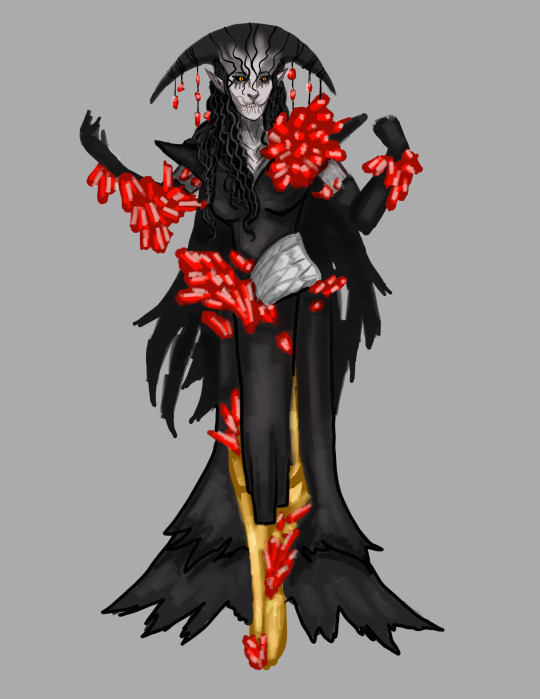
Andruil- Goddess of the Hunt (Da4)
33 notes
·
View notes